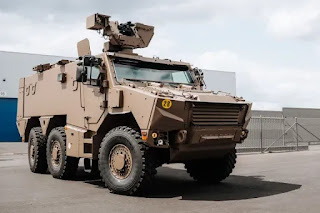Franco-Belgian CaMo Program Delivers First Griffon VBMR to Boost European Defense Cohesion
Belgium’s acquisition of the Griffon VBMR (Véhicule Blindé Multi-Rôle) marks a pivotal moment in its ongoing military modernization efforts. The delivery of the first unit, officially presented on July 15, 2025, in Staden, West Flanders, represents the tangible outcome of the Franco-Belgian CaMo (Capacité Motorisée) program initiated in 2018. This intergovernmental agreement aims to harmonize military capabilities between the two nations through joint procurement, training, and operational integration.
 |
| Griffon VBMR. Belgian Ministry of Defence |
The Griffon VBMR is a 6x6 wheeled armored personnel carrier developed under France’s Scorpion program to replace aging VAB vehicles. With a combat weight of 25 tons, the vehicle is powered by a Renault Trucks 6-cylinder turbo diesel engine delivering 400 horsepower, paired with a ZF 7-speed automatic transmission. It achieves a top speed of 90 km/h and offers an operational range of 800 km. The vehicle’s protection meets NATO STANAG 4569 Level 4 standards, enabling resistance against 14.5 mm armor-piercing rounds, artillery fragments, and explosive threats such as mines and IEDs.
Belgium’s version of the Griffon incorporates several adaptations to meet national operational requirements. These include remote-controlled weapon stations from FN Herstal, capable of mounting 7.62 mm and 12.7 mm machine guns, as well as a 40 mm automatic grenade launcher. The vehicle also features smoke grenade launchers and modular armor kits that can be added to enhance survivability. The onboard Scorpion Combat Information System (SICS) facilitates real-time tactical data exchange, contributing to improved battlefield coordination.
Final assembly of the Griffon takes place at Mol Cy’s facility in Flanders, where Belgian-specific subsystems are integrated. This includes painting, testing, and equipment installation. The company invested in a 5,500 square meter facility and trained its personnel at the Scorpion production line in Roanne, France. This industrial collaboration supports domestic job creation and technology transfer, aligning with broader goals of strengthening Belgium’s defense industry.
The rollout of the Griffon is part of a larger procurement strategy under the CaMo program. Belgium plans to acquire 382 Griffon vehicles by 2031, alongside 60 Jaguar armored reconnaissance vehicles and 24 Griffon MEPAC mortar carriers. The Griffon SAN variant will serve medical evacuation roles, while other configurations will support command, infantry, and engineering functions. These vehicles are expected to replace the Dingo fleet currently in service.
Operational deployment of the Griffon is scheduled to begin in 2026 with the Liberation – 5th of the Line Battalion. This transition will involve the integration of new communication and tactical systems, reflecting a broader shift toward digitized and networked warfare. The vehicle’s modularity allows for future upgrades and variant development, ensuring long-term adaptability to evolving mission profiles.
The CaMo initiative also emphasizes interoperability with the French Army. By aligning equipment, doctrine, and logistics, Belgium and France aim to enhance joint operational capabilities within NATO frameworks. This approach mirrors similar binational efforts, such as Luxembourg’s plan to equip a joint reconnaissance battalion using Griffon, Serval, and Jaguar vehicles starting in 2025.
From a strategic perspective, the Griffon’s introduction reflects Belgium’s intent to meet NATO capability targets and contribute to European defense integration. The vehicle’s participation in the upcoming National Day parade on July 21, 2025, serves as a public demonstration of this commitment. Two Griffon units will be featured in the military procession, while a third will be displayed at the Defence Village in Brussels.
The broader implications of the CaMo program extend beyond hardware acquisition. By fostering industrial cooperation and standardizing military assets, Belgium positions itself to play a more active role in multinational operations. The program also underscores the importance of long-term planning in defense procurement, with final deliveries expected by 2031 and operational readiness projected to span three decades.
Belgium’s integration of the Griffon VBMR into its armed forces represents a multifaceted advancement in mobility, protection, and interoperability. The vehicle’s technical specifications, modular design, and digital systems align with contemporary military requirements. Through strategic partnerships and domestic assembly, Belgium not only enhances its defense capabilities but also reinforces its role within NATO and the broader European security architecture.





